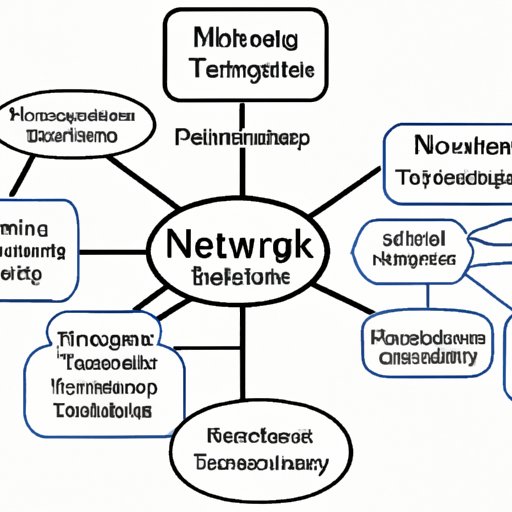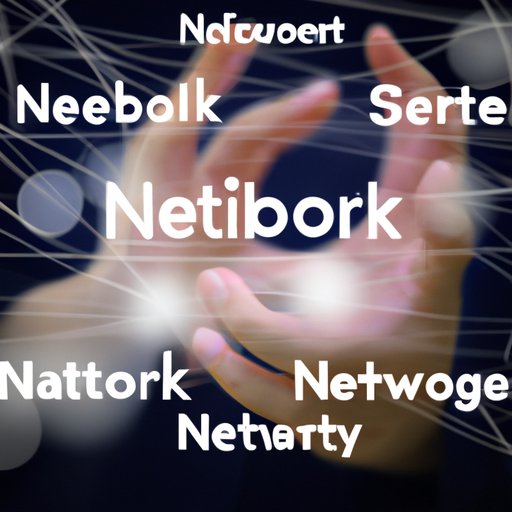Introduction
Networking technology is a broad term that encompasses the tools, protocols, and hardware used to connect computers and other devices to form local area networks (LANs) and wide area networks (WANs). Networking technology is essential for modern businesses and organizations, allowing them to share resources, collaborate with remote teams, and access data from any location. In this article, we will explore the basics of networking technology, the different types of networking technology, the benefits of using it, and the future of networking technology.
Exploring the Basics of Networking Technology
What is Networking Technology?
Networking technology is a combination of hardware, software, and protocols that are used to create and maintain communication between two or more devices. A network can be as simple as two computers connected by a cable, or as complex as a global system of interconnected networks. Networks are used to share resources such as files, printers, web servers, and storage devices, as well as to communicate with each other via email, instant messaging, and video conferencing.
How Does Networking Technology Work?
Networks rely on two basic components: hardware and software. Hardware includes the physical components of the network such as routers, switches, cables, and wireless access points. Software includes the protocols used to establish connections and transfer data between devices, such as TCP/IP. When two devices want to communicate, they use these protocols to send and receive data over the network.

Types of Networking Technology and Their Uses
Local Area Networks (LANs)
A local area network (LAN) is a type of network that connects computers and devices in a small geographic area, such as a home, office, or school. The most common type of LAN is an Ethernet-based network, which uses cables to connect devices to a central switch or router. LANs allow users to share resources such as files, printers, and Internet access.
Wide Area Networks (WANs)
A wide area network (WAN) is a type of network that spans a larger geographic area than a LAN, such as multiple offices in different cities or even countries. WANs are typically used by large organizations to connect multiple locations. They can be either private networks, such as leased lines, or public networks, such as the Internet.
Wireless Networks
Wireless networks use radio waves to transmit data between devices without the need for cables. Wireless networks are often used in homes and businesses to provide Wi-Fi access to the Internet and to facilitate communication between mobile devices. Wireless networks can be either ad hoc networks, which connect two or more devices directly, or infrastructure networks, which connect devices to a central access point.
Cloud Computing
Cloud computing is a type of network technology that allows users to access applications and storage over the Internet. Cloud computing eliminates the need for expensive hardware and software, as users can access services and data from anywhere with an Internet connection. Popular cloud computing services include Google Drive, Dropbox, and Microsoft Azure.

The Benefits of Networking Technology
Networking technology has many advantages for businesses and organizations. One of the biggest benefits is increased productivity, as employees can access resources and data from any location. Networking technology also enables improved collaboration, as teams can easily share information and work on projects together. Finally, networking technology can save businesses money by eliminating the need for expensive hardware and software.

Network Security and Networking Technology
The Importance of Network Security
Network security is an important consideration when implementing any type of networking technology. As networks become increasingly interconnected, they become vulnerable to threats such as malware, viruses, and hackers. To protect networks, businesses should implement strong security protocols such as firewalls, antivirus software, and encryption.
Network Security Protocols
Network security protocols are sets of rules that specify how data is transmitted and received over a network. Common network security protocols include Transport Layer Security (TLS), Secure Sockets Layer (SSL), and Internet Protocol Security (IPSec). These protocols help ensure that data is kept secure while in transit.
An Overview of Networking Technologies and their Applications
Networking in Business
Networking technology is essential for modern businesses. Companies use networks to share resources, communicate with customers and partners, and access data from any location. Businesses can also use networking technology to create virtual private networks, which allow remote workers to securely access the company’s internal systems.
Networking in Education
Networking technology is also widely used in education. Schools use networks to connect students and teachers, share files and resources, and facilitate online learning. Networking technology is also used to connect schools to each other and to the wider education community.
Networking in Healthcare
Networking technology is becoming increasingly important in healthcare. Hospitals and clinics use networks to store and share patient records, transfer images and data, and collaborate with other healthcare providers. Networking technology is also used to connect medical devices such as monitors and ventilators to each other and to the Internet.
The Future of Networking Technology
Artificial Intelligence
Artificial intelligence (AI) is expected to play an increasingly important role in networking technology in the coming years. AI can be used to automate network management tasks such as monitoring and configuration, as well as to detect and respond to potential security threats. AI can also be used to analyze network traffic and optimize performance.
5G Networks
5G networks are the next generation of wireless networks, providing faster speeds and lower latency than existing networks. 5G networks are expected to revolutionize the way people use the Internet, enabling new applications such as augmented reality and autonomous vehicles. 5G networks are currently being rolled out in many countries around the world.
Edge Computing
Edge computing is a type of distributed computing that moves processing away from centralized data centers to the “edge” of the network. Edge computing reduces latency and improves performance, making it ideal for applications such as streaming media and industrial automation. Edge computing is expected to become increasingly important in the coming years.
Conclusion
Networking technology is essential for modern businesses and organizations. It enables increased productivity, improved collaboration, and cost savings. Network security is also an important consideration, as networks are vulnerable to malicious threats. Networking technology is also evolving, with advances such as artificial intelligence, 5G networks, and edge computing expected to revolutionize the way people use the Internet.
(Note: Is this article not meeting your expectations? Do you have knowledge or insights to share? Unlock new opportunities and expand your reach by joining our authors team. Click Registration to join us and share your expertise with our readers.)
